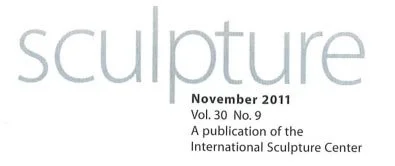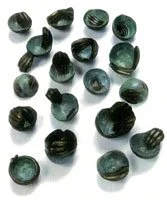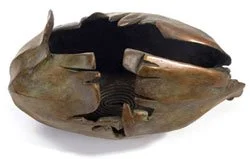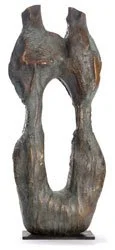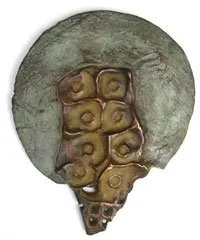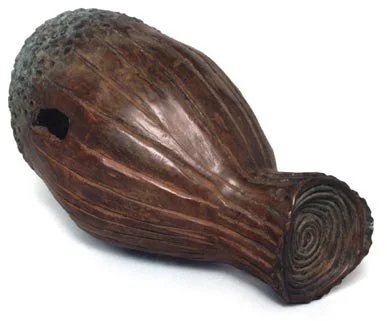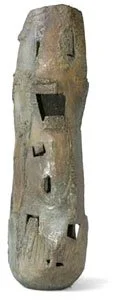Glass and Bronze Together
November 16, 2011
….Last year, Weil received the PSC-CUNY Research Foundation Award for a project to study the fusion of glass and bronze. She applied for the grant to pursue a new artistic direction so she could keep pushing herself forward as an artist, she said.
Weil is now nearing the end of a year-long journey in exploring how blown glass and poured bronze can meet and marry in art. A recent group show at Art Sites was the first presentation of glass work, so far. Showing Weil’s first series with a new medium was a no-brainer, said Berry. “Even though it’s a new medium, she brings a connection from the work she was doing previously,” Berry said. ”She [Weil] has always been interested in transparency. The hole in the bronze and the form that she’s developing with the glass allows her to push the envelope even more.”
…..In her recent exhibition, “Ad Fundum: New Bronze Work,” she takes a giant leap through the millennia-a shift in time, accompanied by a shift in perspective…… Here, (Panóias, northern Portugal) Weil began her studies for two new sets of work- “The Panóias Cycle” series and The Dig. In these works, she evolves a new style, laying the geometry of civilization over familiar organic forms and substituting the stuff of the 21st century for nature-inspired Neolithic signs and symbols. All of this tells us that we are but a tick on the cosmic clock, that millennia from now, traces of our presence will appear only marginally different from the remains of our prehistoric and ancient brethren.
Joyce Beckenstein
Sculpture Magazine, November 2011
“…Now she has extracted the spirals, grids and punctured outlined shapes embedded in those haunting pieces and placed them in organically shaped vessels of golden-hued blown glass. “Bullseye,” for example, holds a piece of industrial copper bent into a spiral, a primordial symbol of nature and a repeated motif in Ms. Weil’s sculpture. Here the human-made detritus of contemporary life is effectively suspended like an embryo in light, much as amber seals prehistoric remains. The viewer’s reflection in glass completes the metaphor.”
Download the full article
Joyce Beckenstein
October 27, 2011
Someone not already familiar with the sculpture of Marianne Weil might swear that her recent bronzes - all channeling what appear to be museum-quality artifacts - were unearthed at some ancient dig. And, in some ways, they could have been, because Weil’s work, indeed her modus operandi, brings the beauty and the mystery of ancient civilizations to a contemporary audience. Download the full review.
Ed Rubin
June 2009
Kouros Gallery Exhibition Catalogue - Los Millares
2008 - Weil feels a kinship with the prehistoric masons who shaped their surroundings for defense and domestication, for practical needs and for worship. Their utilitarian projects are inherently sculptural; even as ruins, their works’ sophistication is evident. But Weil is not interested in trying to re-imagine or replicate such prototypes. Instead, she uses them as springboards for her imagination, extrapolating from them the way an improvisational musician takes a theme and expands upon it until it becomes his or her own creation.
I once wrote that Weil’s sculpture inhabits “the grey area between the organic and the mineral realms,” and she continues to explore that territory in her current work. ….This magical melding of the biological and the geological that captivated me more than a decade ago is still one of Weil’s guiding principles. Although made of metallic bronze, her objects seem animated, spirited, and full of energy. Like the totems and fetishes of ancient cultures, they stand for something beyond themselves, even as they represent a contemporary vocabulary of formal exploration and invention.
Helen A. Harrison, Director,
Pollock-Krasner House and Study Center
“The seed is in the ground. Now we may rest in hope.”
This line of poetry, written by Wendell Berry was the inspiration for Seed, a bronze monument by Orient sculptor Marianne Weil. Commissioned by the Sisters of St. Dominic of Amityville, it will be installed on the west end of the Water Mill Village Green later this summer. The work is a commemoration of the Sisters’ 75 years of stewardship of the land, as well as their longtime commitment to the community as a spiritual center in the heart of the village. The Village Green was donated to Water Mill when they departed the area in 2005-and Seed will stand as a lasting legacy of their years of heartfelt dedication to the community…. “The sculpture has the apparent texture of a stream or river, and it blended right in with the theme of the commission.” The flowing passage of time and the creation of a lasting legacy for future generations is a theme that runs consistently through her work.
Lisa Finn
July 23, 2008
The sensuality that her current bronzes exude can be traced to the fact that Weil builds her hollow pieces directly from wax, her fingers and tools leaving impressions inside and out, before each is cast uniquely. Their surfaces marked by pits, incised lines and punctures, bring to mind excavated artifacts….Weil’s search for a personal vocabulary that reinvents the lost ritual functions of excavated treasures seemed implicit in that (Twenty-six Madeleine’s) assembly. Download the full review.
Elisa Decker
November 2008
Marianne Weil’s life work revolves around the theme of legacy. Her abstract bronze sculptures carry forward the spirit of ancient megalithic cultures of Europe, while the lost-wax process she uses to create them is a throwback to an earlier time. As a professor, she feels “teaching carries on a legacy and has a lasting influence on sculpture in the world.” She teaches her students’ specialized skills along with knowledge of art history so they can appreciate the historical context of their processes while they pursue their own contemporary styles and statements.
Marilyn Noble
Winter 2007
Kouros Gallery Exhibition Catalogue -
The Beaghmore Cycle & Recent Bronzes
...Thematically, her (Weil’s) choices lean toward ancient sources, represented by her recent series entitled The Beaghmore Cycle. These pieces, inspired by contact with Neolithic sites in Ireland, coincide and resonate with Weil’s ongoing bent toward ritualistic mystery, relationships with nature and predilections for female shapes.
Her preference for organicism is manifest in an emphasis on asymmetry over symmetry and modulation over strict adherence to geometric constructs. Circular, and vessel shapes often suggest female anatomy, especially torsos or breasts. Overlays of subtle patina tones both soften and accentuate pierced, gouged, scraped, and stamped surfaces. Overall configurations complimented by textural details result in a strong tactile appeal combined with visual attraction that at once engages the eye while tempting the hand.
The sensitivity and vulnerability of Weil’s work bears testimony to the intersection of ephemeral existence with the continuities of humankind and nature. The presence of her oeuvre as a whole belies an enigmatic mystique evoking a sense of recognition in our collective subconscious as well as our individual souls. Download the full Judy Collischan statement
Judy Collischan, Ph.D,
Author of Welded Sculpture of the Twentieth Century
June 2006
Bronze casting is an ancient craft, but artist Marianne Weil has turned it into a fresh new way to teach the value of art and higher education to a group of Greenport students.
In a unique art project, a dozen Greenport High School students are collaborating on a large bronze sculpture that will eventually be on display in the community. The project (MariTime Bronze) is funded by a $5,000. grant from the New York State Council for the Arts. Only a few Suffolk County artists and art organizations are awarded the highly competitive grants each year.
Gwendolen Groocock
April 14, 2005
“Ms. Weil’s two- and three-dimensional pieces suggest in their textures and patina an ancient narrative frieze or ceremonial relic...”
Liz Wood
May 25, 2000
“Sculpted directly in wax and mixed media, these unique castings are appealing on many levels. For one, they instantly evoke the texture and sensibility of hand-sculpted pottery. “Columbia,” a spherical object, is textured with crater-like holes around its entirety. Like an enlarged, primeval Fabergé egg “Columbia” provokes the viewer to touch and marvel at its surface. Both “Sogno,” a gourd-like object, and “Trace,” also bear the crater holes and marks which categorize Ms. Weil’s works. “Atlas,” a long, thin figurative object, looks oddly— and amiably—like a giraffe with a globe for a head. An abstracted creature, “Atlas,” resembles Giacometti’s figurative works....”
Erica-Lynn Gambino
April 23, 1998
“...Unlike many artists who work in bronze, after her pieces have been cast by the foundry, Weil does all the finishing, chasing and patina work herself. ...While (she) incorporates natural materials into her bronzes, there is something distinctly deliberate in the placement of these materials that speaks to civilizations now long departed from the terrain we think we know so well. Whether inspired by the Polynesians whose sacred rock structures still dot the Hawaiian landscape, or the megaliths of Brittany, for Marianne Weil, the voice of the ancients speak across oceans and time.”
Annette Hinkle
April 2, 1998
“There were depths to this exhibition that made it more than just a look at Marianne Weil’s work of the past few years. The steadfastness of bronze and the strength of the artists relationship with the material were pervasive.
…Weil works with bronze as a material, from modeling the pieces directly in wax to applying the patinas. There is a hands-on sculptorliness to the work that reveals its roots in a postwar vocabulary-- Weil’s references-from cultural anthropology to the body-are strictly her own…more easily compared to her baby-boomer generation’s attraction to Surrealism and biomorphic forms… In fact it’s amazing what a diversity of potentialities Weil’s vertically oriented, upright forms embrace--almost literally. In silhouette, many of the works stand like people or confront like torsos.
….Intimacy and public address exist here side by side. The inspiration behind each of these works always seems to be broad and far reaching humanity.” Download the full review.
Cynthia Nadelman
November 2004
“Marianne Weil juxtaposes her bronze sculptures with prints by Ellen Weiner and paintings by Myrna Burks to highlight the effects of layering in various media...the subtle buildup of tones and textures in Ms. Weil’s rich patinas, in the diptych ‘During the Fall I and II,’ ...”
Helen Harrison
June 4, 2000
New York Times Sunday Art Review
"There is a degree of sophistication in Ms. Weil's three-dimensional and relief bronzes that incorporate bits of exotic nature in their schemes. Some of the most elegant examples were inspired by a residency fellowship in Hawaii. In all, a handsome, carefully toned and worked patina is important to the impact."
Phyllis Braff
April 19, 1998
The New York Times
“The lament of a land-bound spirit inspired Marianne Weil to inscribe a line from Emily Dickinson on the slates of a winding path in the waterfront park at the bus terminal off Fourth Street. ‘Futile the winds to a heart in port’ poignantly evokes the longing for the absent lover, yet is equally valid as a sailor’s yearning to return to the sea.”
Helen Harrison
August 3, 1997
“...whether freestanding or emerging as relief elements embedded in a background slab, her images combine found and invented shapes...caught in the gray area between the organic and mineral realms...Like fossils or primitive life forms trapped in amber, Ms. Weil’s intriguing specimens have overtones of both biology and geology.”
Helen Harrison
September 1, 1996


